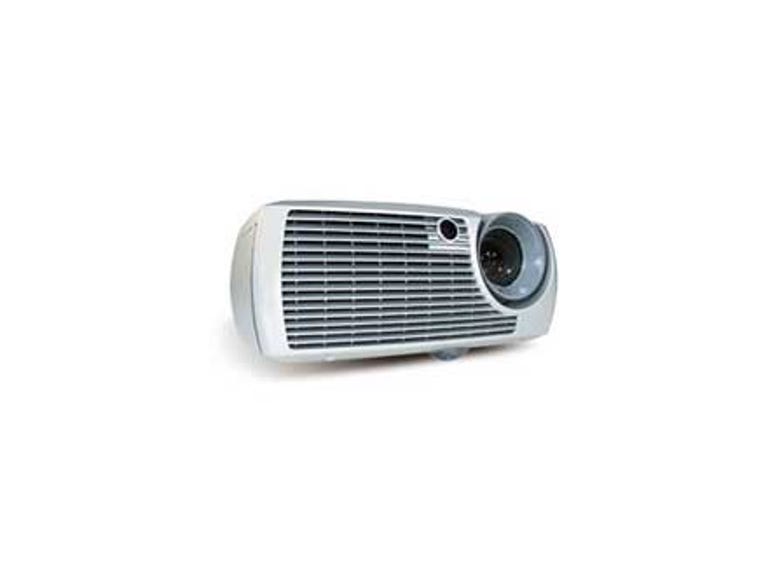 Why You Can Trust CNET
Why You Can Trust CNET InFocus ScreenPlay 4800 review: InFocus ScreenPlay 4800
InFocus ScreenPlay 4800
Design
At a respectable 24.9 x 31.8 x 10.5cm, the 4800 doesn't take up too much living room space. It is narrower and longer than the Infocus' LP640 boardroom model, which gives the unit a slightly squashed look.
Watching regular TV channels is no problem as the 4800 supports a 4:3 aspect ratio. Normal broadcasted television signals need to be first passed through a tuner, such as a VCR or cable set top box; you cannot plug a coaxial cable straight into the projector. For widescreen DVDs, the ScreenPlay 4800's also displays 16:9 images.
The Good
The Bad
The Bottom Line
Features
Multiple video sources allow you to connect to several pieces of equipment in your living room, such as a DVD player, games console, digital video recorder or computer. At the back of the device are inputs for regular video and S-video. There is also a 3.5mm audio jack if you can bear listening to the 4800's tinny sounding speakers.
For PC connections, there are monitor input and output ports as well as a USB connection that allows control of a mouse for presentations (a separate remote is needed).
Packaged with the ScreenPlay 4800 is a home entertainment remote that controls source, contrast, brightness, image presets and navigates the on-screen menu. A handy button on the side of the remote illuminates the keys in red, which helps find buttons in the dark.
InFocus provides all the accessories you'll need to get the 4800 up and running: S-video cable, component (3 RCA) to S-video adapter, component (3 RCA) to HD15 adapter, AV cable, computer cable, as well as a power cable.
The 4800 has a modest native resolution of 800 x 600 pixels (SVGA), but can automatically scale images for computers set to higher resolutions with minimal blur.
Performance
In a dimly lit or dark room, the contrast ratio of 2000:1 ensures colours are vibrant blacks do not appear grey. However, this is a 1100 ANSI home projector and images get washed out in fluorescent office environments or bright rooms in daylight.
Texas Instruments' digital light processing (DLP) technology powers the 4800 and images aren't plagued by the noticeable "screen-door" effect common with LCD projectors.
However, we did occasionally notice a "rainbow effect", where you see (for a millisecond) a section of the image deconstruct to three primary colours when quickly shifting your focus from one side of the screen to the other. Thankfully, many people are oblivious to this and we advise potential buyers to try out the projector first to see if they observe the anomaly.
According to InFocus, the 150W lamp lasts 4,000 hours usage and replacement bulbs cost AU$600. This works out to be AU$0.15 per hour to run, which is relatively inexpensive.
The optical zoom on the ScreenPlay 4800 can increase image size by about 20% and is manually adjusted via ring around the lens of the projector. There is a separate ring in front of it for focusing.
Images are thrown at a ratio of 1.89:1 - 2.27:1, depending on the extent of the zoom. So, for a room with four metres available from projector to the screen/wall, diagonal size of the image is about 220cm to 264cm (87" to 104") for 4:3 viewing.
If you want to mount your projector on the ceiling, the image can be flipped vertically through the 4800's menu. Ceiling mounts from InFocus cost an extra AU$300.
Built-in vertical digital keystone can correct trapezoidal-shaped images due to off centre placement of the projector up to twenty degrees. However, the 4800 has no horizontal digital keystone correction.
In the back corner of the unit is a rotating leg to tilt the projector to the required level and pop-out stand at the front to adjust height.
Tipping the scales at 3.1kg, the 4800 is quite light to carry short distances. InFocus provides a basic soft carry case with an accessory pouch to assist portability. This snug over-the-shoulder bag isn't too sturdy so if you plan on regularly travelling with taking the 4800 it's probably a good idea to invest in a stronger case.
Support information for the ScreenPlay 4800 comes in a printed user manual and further information, including FAQs and installation guides, can be found on the InFocus Web site. InFocus gives two years warranty for parts and labour and one year warranty for accessories.
The ScreenPlay 4800 is an affordable way to start your home theatre with the projector retailing at AU$2,499. Combined with a decent audio setup, it will surely impress friends coming over to watch a DVD, battling it out on a console game, and at grand final time.


